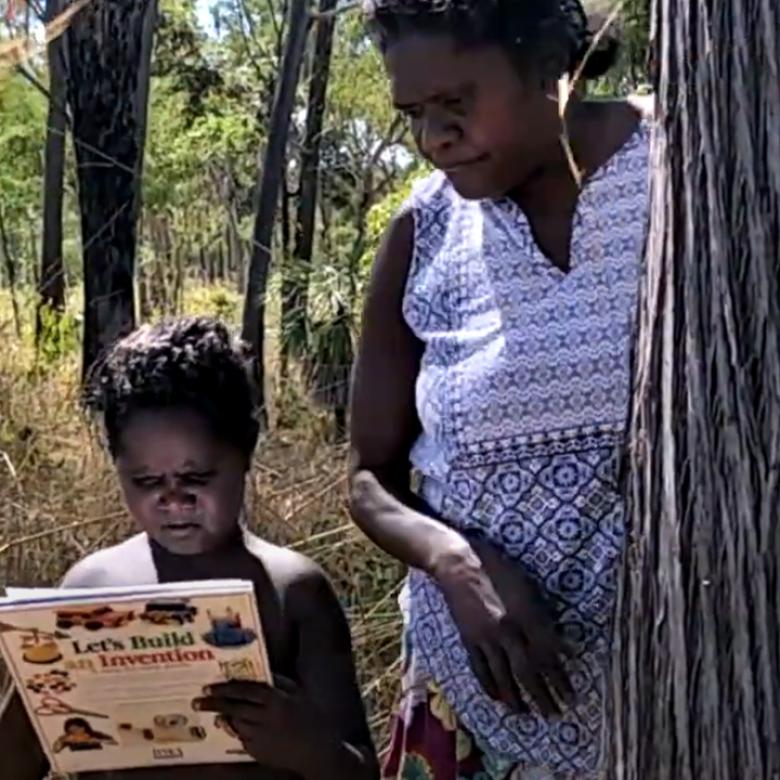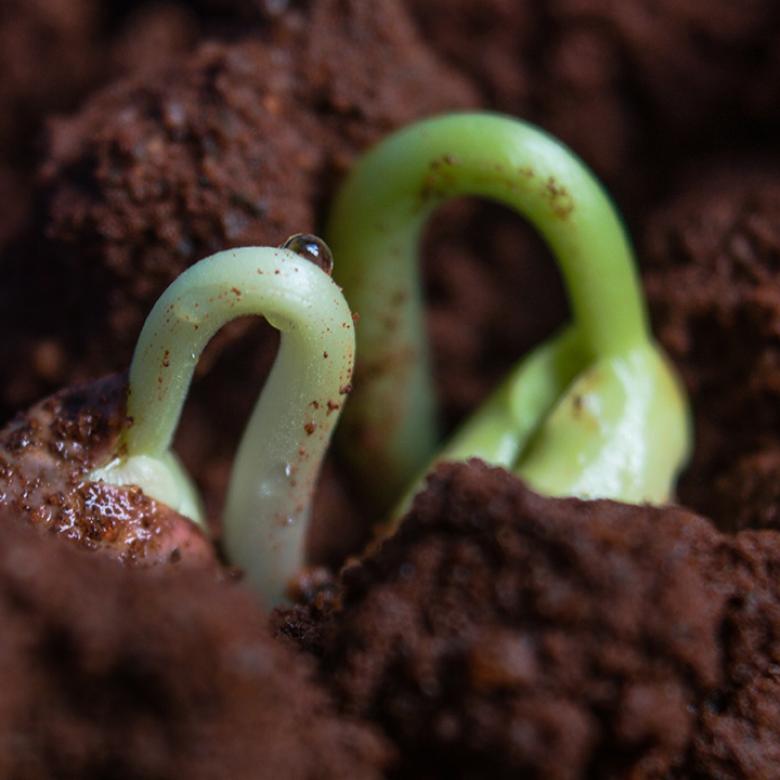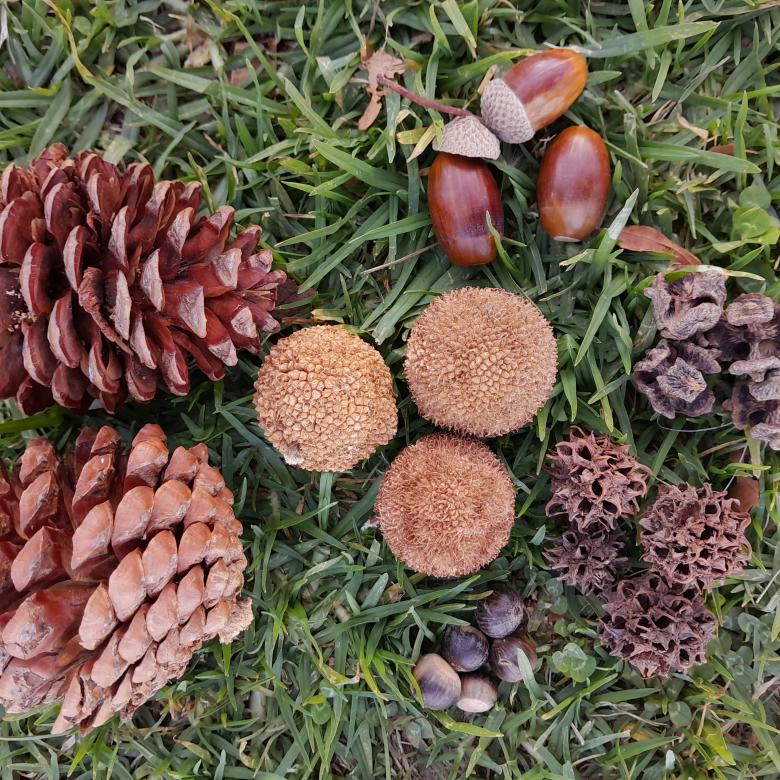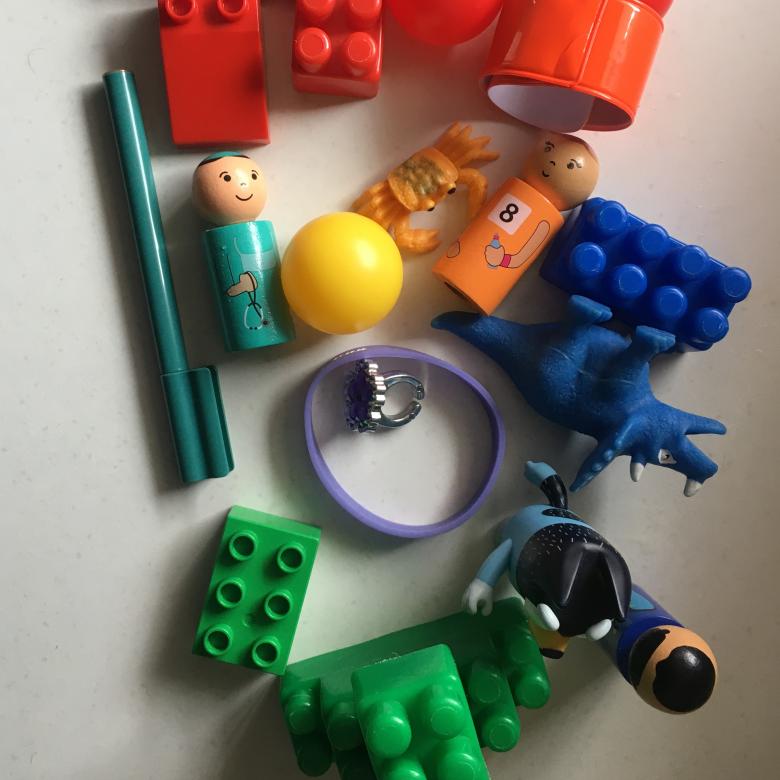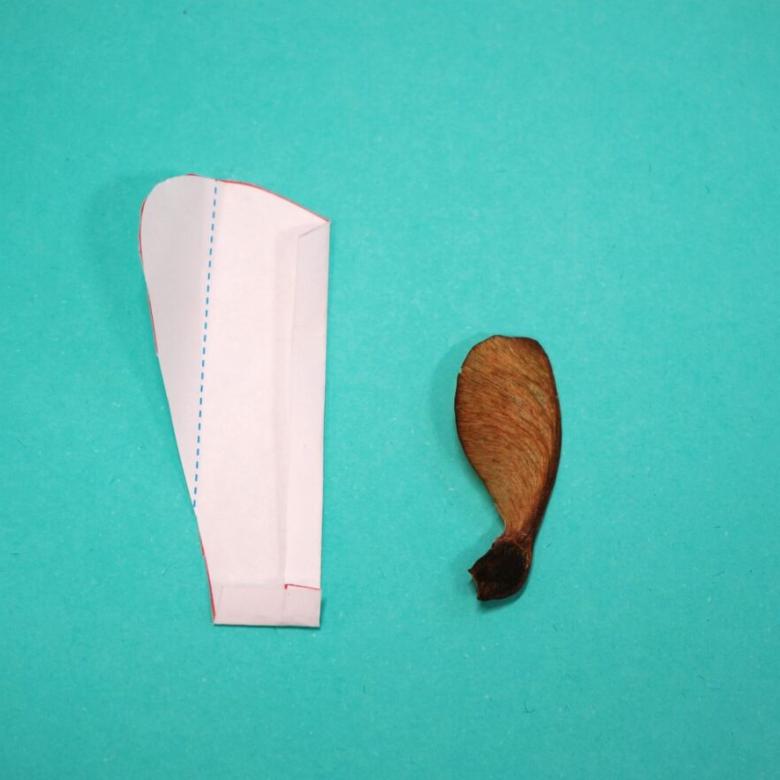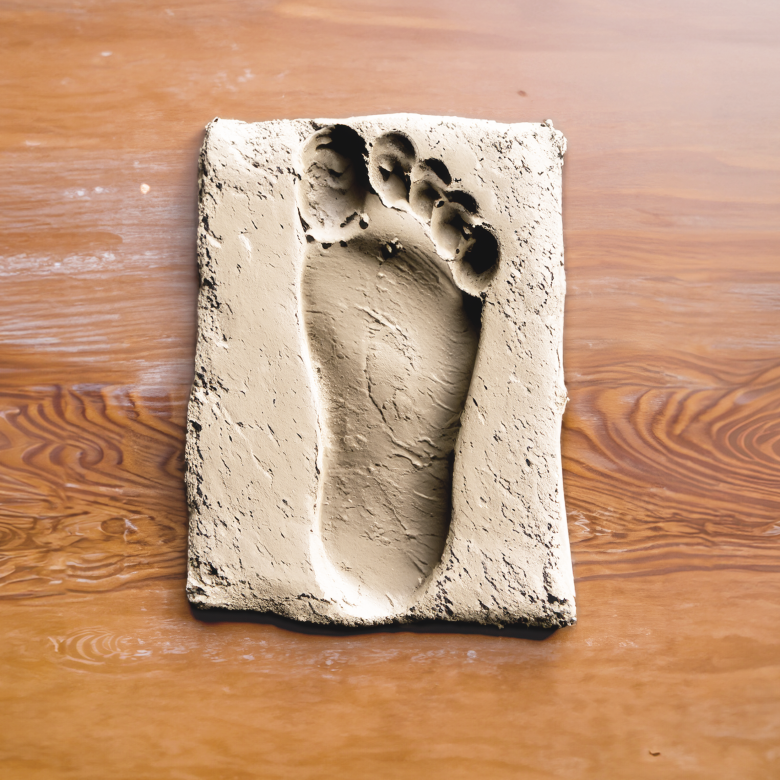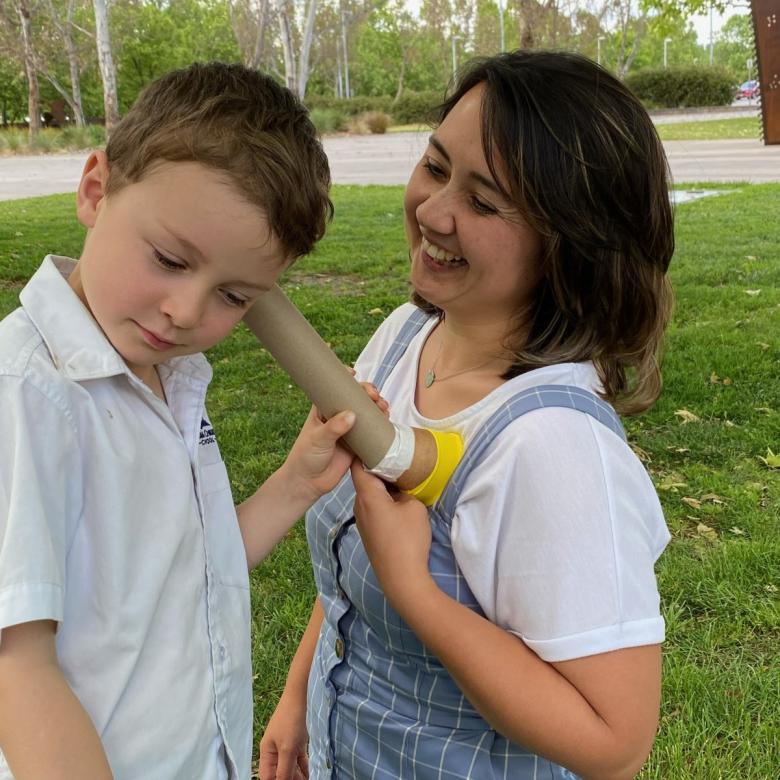You’ll need
- A large body-sized piece of paper or cardboard (or smaller pieces of paper taped together), or a flat area of concrete
- Textas, crayons or chalk
- A book or website about the human body
What to do
- Have your child lie down on their back on the paper or concrete. Trace around their body using the textas, crayons or chalk. This is the outside of their body. Now they need to draw the inside!
- Ask your child what they know about the inside of their body and help them draw these things on the body diagram.
- Look in a book or on a website about the human body to find other bones and organs that your child might not know about. Talk about what these body parts do as you draw them. Point to these places on your child’s actual body to show where the different parts are.
- Draw some of your child’s bones on the body diagram, like their skull, ribs and hips. Point to these bones on your child’s actual body, and ask them if they can you feel the hard bones inside? Ask them how many bones they think they have in their body.
- Draw your child’s lungs on the body diagram. Ask your child to put their hand on their chest and take a deep breath in. Ask them: Where does the air go? Can you feel your lungs getting bigger? Ask them to breathe out, and then ask them: Can you feel your lungs getting smaller? Can you hold your breath?
- Draw your child’s heart on the body diagram. Ask them to put their hand on their chest, or on a pulse on their wrist or neck. Ask them if they can feel their heartbeat. Now get them to jump up and down 20 times or run around a bit, then feel their heartbeat again. Ask them if it got faster? Why?
- How does our blood move around our bodies? Have your child look at their wrist, and ask them if they can see the blue lines. These are veins that help carry blood around our bodies.
- Talk about what happens to food after we eat it. Draw the path that food takes through our bodies. Ask them what comes out the other end.
Questions to ask
Where are your stomach, heart, lungs and brain?
What do each of these organs do?
What's happening
Young children are fascinated by their bodies. By drawing their own body, they can learn a lot about how their body works.
Did you know
- The bones in your body make up your skeleton. Without bones, we would be all floppy like a jellyfish. The head bone is called the skull. It protects our brain just like a bike helmet. The adult human body has 206 bones.
- The biggest bone in our bodies is our thigh bone, also called the femur. Our biggest muscle is in our bottoms, called the gluteus maximus.
- Your lungs are how you breathe. The smallest parts of your lungs are called alveoli. These are like lots of tiny balloons that get bigger when you breathe in and smaller when you breathe out.
- Your heart pumps blood around your body. Blood carries oxygen to your muscles. When you exercise, you breathe harder and your heart pumps faster to take more oxygen to your muscles.
- Your stomach breaks food down into smaller parts that can pass through the rest of your body easily. A full stomach can be nearly 30 times bigger than when it’s empty!
Dion: Hi, and welcome to Questacon Science Time. My name is Dion.
(Waving)
BJ: And I’m BJ.
Dion: And today we’re talking about inside the body.
BJ: Let’s go.
(Science Time logo)
(Singing)
Wake up sun and moon, it’s Science Time, it’s Science Time.
Wake up skeleton, it’s Science Time, it’s Science Time.
At home in the bathroom, when we’re swimming there is science,
Outside at the playground, in the sunshine, there is science.
Wake up.
(Science Time logo – Title, “Inside the Body”)
Dion: Now, if everyone looks around the room today, what do you think we might be talking about in Science Time?
Child: Skeletons.
Dion: Skeletons. What else do you think maybe?
Child: Dinosaur bones.
Dion: Ooh, don’t know whether... we’re looking at human bones today. Human bones.
Child: Did you know there are just some dinosaur bones that are left around here.
Dion: Yeah, there might be; there might be some.
Child: But we saw a dinosaur.
Dion: Did you? Well today we’re going to talk about our bodies though, so we usually... we can talk about dinosaur bones and stuff, but today we’re actually going to talk about our bones.
BJ: Hmm.
(BJ smiles and nods her head)
Dion: What other things... we’re actually going to talk about inside the body, what other things are inside our bodies. Can anyone tell me?
Child: Bones.
Child: Bones.
BJ: Yes, lots of bones.
(BJ nods her head)
Dion: Bones? Very much so. What other things are inside our bodies?
BJ: What else?
Child: Blood.
BJ: Oh, yes.
Dion: Blood. Blood is very important. We’ve got blood inside our bodies. How about we were talking about breakfast before, where does our breakfast go after we eat it?
Child: In our tummy.
(Child smiles and points to her tummy)
BJ: Yeah.
Dion: In our... where’s your tummy? Can you show me where your tummy is? Where’s your tummy?
BJ: Where’s your tummy?
(Children point to their tummy)
Dion: Its right here, isn’t it? So you’ve got a tummy.
Child: And you know what... and you know what um the food turns into?
Dion: What does the food turn into?
Child: Poo.
Dion: It does turn into poo, and we’re going to talk about how that that food turns into poo very, very soon.
BJ: Yes.
(BJ smiles, and then nods her head and laughs)
Dion: Now, what else is inside of our bodies? Can anyone think of anything else?
Child: Um, they turn into milk.
Dion: Some with milk. Well how about there’s something very important inside our head; what’s inside our head?
Child: A brain.
Dion: A brain!
(BJ laughs)
We’re going to be talking about brains today as well. So what we might do is I might introduce you to someone called Ana-tomy first of all. Now Ana-tomy is a very, very special sort of person, because we can see all of her insides – we can see all of her insides – so this is Ana-tomy over here.
BJ: She’s a very special doll.
(BJ and Dion remove the cover from the doll)
Here we go.
Dion: There we are. Now Ana’s, all her inside bits we can actually see. Now first of all, we’ve already talked about this bit, but can anyone tell me, what is this bit here?
(Dion and BJ point to the doll’s brain)
Child: The head.
Dion: It’s the head.
Child: It’s brain.
Dion: The brain. The brain.
BJ: Yes.
Dion: Very, very important. Now, what do you use your brain to do?
Child: Think.
Dion: You use it to think, don’t you?
(Camera zooms in on the doll’s head)
BJ: Hmm. Hmm.
Dion: Now what I want everyone to do, we’re going to use our brains now, I want everyone to wiggle your fingers and toes – can everyone wiggle your fingers and toes?
(Everyone wiggles their fingers and toes)
Wiggle, wiggle, wiggle, wiggle. What’s happening is your brain is sending a message to your fingers and to your toes and it says, “Wiggle fingers; wiggle toes,” and they start to wiggle.
(BJ looks at the camera and smiles)
BJ: Can you wiggle your toes?
Dion: Now, if you stop wiggling your toes – can you stop wiggling your toes and your fingers?
(Everyone stops wiggling their toes and fingers)
What happened is your brain sent another message to your fingers and to your toes, and said, “Stop wiggling toes; stop wiggling fingers,” and that’s why they stopped. So our brain is really, really important because it helps us do all the things we need to do. It helps our bodies do all the important stuff.
Child: And do you know... do you know something else what brains do?
Dion: What else does a brain do?
Child: Make you to do your... get your breath.
Dion: Yeah, it helps you breathe as well, doesn’t it? Which leads me onto the next bit we’re going to talk about – these also help us breathe – our brain helps us breathe, but these help us breathe too.
(Dion points to the doll’s lungs)
I’ll give you a... I’ll give you a clue; we do breathe with them.
Child: Skeleton’s boobs(?).
Dion: No. Well, it’s actually its lungs. Can everyone say lungs for me?
(Children say collectively)
Children: Lungs.
BJ: Lungs.
Dion: Lungs. Now, lungs, they are in your chest, and they help you breathe, so about here.
(Dion removes the lungs from the doll and places them on his chest)
Dion: Now can everyone take a big breath in for me?
BJ: Take a big breath.
(Everyone takes a deep breath)
Dion: And a big breath out.
(Everyone breaths out)
Your lungs are what’s helping you breathe. So it’s like your lungs are made out of tiny little balloons, and those balloons get bigger when you breathe in and smaller when you breathe out.
(Camera zooms in on the lungs Dion is holding)
(BJ breaths in deeply, and then breathes out)
So I want everyone... can everyone put your hands on your chest for me, and breathing in for me.
(Everyone places their hands on their chest and breathes in deeply)
And breathing out.
(Everyone breathes out)
You might have felt that your lungs got bigger as you breathed in, and smaller as you breathe out. Give that a try at home as well. Now behind our lungs we’ve got another very, very important bit – this one here.
(Dion points to the doll’s heart)
Now, does anyone know what this organ or body part is?
(Camera zooms in on the doll’s heart)
Child: It’s your heart.
Dion: Your heart. Well done! Now, what sound does a heart make? What do you think?
BJ: Does anyone know what sound your heart might make?
Child: Bom-bom-bom-bom.
BJ: Oh, yes.
(BJ points to the child, then smiles and nods)
Dion: Ba-boom, ba-boom, ba-boom. It makes a ba-boom sound, doesn’t it?
Child: Big... a ba-boom sound, and there’s a teller(?) kind of thing, and when it goes on your tummy it makes noises.
Dion: Yeah, so we’re actually going to talk about that today. That’s called a stethoscope. Can everyone say stethoscope for me?
(BJ reaches behind the doll and brings out a stethoscope and hands it to Dion)
(Children say collectively)
Children: Stethoscope.
BJ: Stethoscope.
Dion: Stethoscope. Has anyone ever seen a stethoscope before?
Child: I do, because I’ve been to the hospital, and to Doctors lots of times.
(Camera zooms in on the stethoscope in Dion’s hands)
Dion: Yeah. So who uses these sorts of things do you think?
Child: Doctors.
Dion: Doctors and Nurses, and that sort of thing. So people that look after your health, they use these sorts of things. Now, if I wanted to listen to my heart, because this is what it does – I can put these bits in my ears, and where would I put this bit to listen to my heart, do you think?
(Dion places the ear piece of the stethoscope into his ears and points to the amplifier of the stethoscope)
Would I put it on my head?
(Dion places the amplifier of the stethoscope on his head)
Child: No.
(Children laugh)
Child: That’s the wrong place.
Dion: Would I put it on my elbow?
(Dion places the amplifier of the stethoscope on his elbow)
Child: No.
Dion: Where’s my heart? Can anyone show me?
Child: A heart is these parts.
(Child points to his chest)
Dion: It’s on your chest, isn’t it? It’s right in your chest. So it’s a bit... it’s in the middle, and a bit to the left. There we are, so if I listen really carefully – ba-boom, ba-boom – I can hear my heart beating using our stethoscope.
(Dion places the amplifier of the stethoscope over his heart)
And that’s what a Doctor or a Nurse does as well; they use these ones to listen to our heart beating. Now, the reason our heart makes this sound is because it’s pumping something all around our body –what is it pumping do you think? You mentioned this earlier.
(Dion points to the child sitting next to him)
It’s stuff that... so if you fall over, or you cut yourself, red stuff comes out – what’s that called?
Child: Blood.
Dion: It’s blood.
BJ: Yes.
Dion: It’s blood. And blood is pumped all around your body by your heart through these things over here.
(Camera zooms in on Dion pointing to the doll’s heart, and to the veins in his wrist)
Child: Do you know I have fallen over and they’re bleeding.
Dion: Sometimes... yeah, when you bleed it is a bit red.
Child: Yes.
Dion: And that’s because you’ve got blood all around your body. Now if everyone has a look at your wrist for me – everyone have a look at your wrist.
(Dion and BJ point their wrists)
(Camera zooms in on Dion’s wrist)
You might be able to see blue lines. Can you see blue lines in your wrist?
(Camera zooms in on Dion’s wrist and Dion points to the veins in his arm)
Child: Hmm, yeah. But I have lots of them.
Dion: These are called veins. These are called veins. So what happens is blood goes all around your body through veins and arteries, and they help to take blood to the tips of your fingers, and the tips of your toes.
Child: I’ve got lots of veins.
Dion: Now what blood does, it actually carries oxygen all around your body.
Child: I’ve got lots of them.
Dion: Do you have lots of veins, do you?
Child: Yeah. See?
(Child holds out his arm for Dion to see his veins)
Dion: You do have lots of them. Now these veins, they’re actually carrying oxygen and blood around your body, so when you breathe in you are breathing in oxygen, and your blood and your heart pumps the oxygen all around your body. What we’re going to do, we’re going to try and get our hearts beating really, really fast. So what I want everyone to do, I need everyone to stand up for me. Can everyone stand up for me?
BJ: Oh, up you get; stand up everyone.
Dion: Standing up.
(Everyone stands up)
And we’re going to see if we can make our hearts beating really, really fast by exercising. So what I want everyone to do, we’re going to run on the spot, so everyone running on the spot.
(Dion starts running on the spot)
BJ: Oh OK, running really fast. Faster!
(Everyone is running on the spot)
Dion: Running as fast as you can.
BJ: Faster! Faster!
Dion: Running!
BJ: Oh, that’s really fast. Faster!
Dion: And keep running. I hope you at home are running as well.
(Camera shots of the children running on the spot)
Dion: Make sure to run, run, run, run, run on the spot.
BJ: Keep running really fast.
Dion: So what’s happening is there’s lots of blood pumping around, we’re exercising lots and lots, we’re almost finished.
BJ: Well done!
Dion: And stop!
BJ: Oh! Sitting down.
Dion: Oh! And sitting down.
(Everyone sits down)
BJ: Now, put your hands on our chest.
Dion: Now, putting your hand on your chest, can you feel your heart beating?
BJ: Just over there.
(BJ helps a child put their hand on their heart to feel it beating)
Child: Yes.
Dion: You probably can. That’s because when we do exercise our muscles in our body need lots and lots of oxygen and blood, so our... first of all we have to start breathing a bit more to get more oxygen, and our heart pumps harder in order to get the blood all around our body a bit faster, so we can get lots more oxygen.
Child: What about the rest of that?
Dion: Well we’re going to talk about this now.
BJ: So wiggle back; sitting on our spots; turn around and find your spot.
Dion: So we’ve talked about our heart, we’ve talked about our lungs, now we’re going to have a chat about other things as well. So could I get you to move back for me; shuffling back? Shuffle back.
BJ: Can we wiggle back onto our spot? Wiggle back. Wiggle back. Well done!
Dion: There we are. Good work.
BJ: Excellent.
(Dion and BJ smile at the children)
Dion: So now we’re going to have a look at this thing here.
(Dion and BJ point to the doll’s liver)
We’re not going to talk much about this body part because it’s a bit complicated, but here we’ve got something called a liver.
(Dion holds up the doll’s liver)
Can everyone say liver for me?
(Children say collectively)
Children: Liver.
BJ: Liver.
Dion: Liver. Now a liver is a bit like a washing machine for our body, it helps keep our blood nice and clean, and helps keep us nice and healthy as well. Now underneath our liver we’ve got this thing here.
(Dion removes the doll’s stomach and holds it in his hands)
Now this is where our food goes when we eat it. So what do you think this might be?
Child: Cheese.
Dion: Ooh, a good guess.
BJ: It goes in our mouth, we chew it, you swallow it.
(BJ points to her mouth, and then moves her finger down along her throat)
Child: And you know, and all the food...
Dion: And it goes down into where do you think?
(Dion points to his tummy)
Child: Tummy.
Dion: Into our tummy.
BJ: Yes.
(BJ smiles and nods her head)
Dion: So if you eat cheese it will go down to your tummy.
Child: And you know... and the chew(?), and all the parts around inside those parts make the poo.
Dion: It’s true.
BJ: Yes, this.
(BJ points to the doll’s intestines)
Dion: Down here, this is where all the poo is made. That is very, very true.
(Dion points to the doll’s intestines)
But before the poo is made, we eat the food, we chew it in our mouths, we swallow it, and it goes down into our stomach.
(BJ points to the doll and moves her finger down from the mouth to the stomach area)
Now our stomach can be big or small, it can stretch if we eat lots of food, and gets a bit smaller if we don’t eat a lot of food.
Child: Yeah. Well I’ve got lots of stomach.
Dion: And it also does something else – it adds digestive juices as well. So this helps us to really get the good things out of our food that we eat. Now after it’s been in our stomach for a little while it goes into these things here – does anyone think they know what this is called?
(Dion removes the doll’s intestines)
Child: Yeah, I know.
Dion: What do you think?
Child: Poo.
Child: Pipetins(?).
Dion: It’s a bit like pipes, isn’t it?
Child: Yeah.
Dion: But it’s actually called intestines. Can everyone say intestine?
BJ: That’s a good word.
(Children say collectively)
Children: Intestine.
BJ: Intestine.
Dion: Intestine. So intestines, these are really, really, really long tubes where all the food goes through, and our intestines take all the good things like the vitamins and the minerals from the food that we eat.
(Camera zooms in on the intestines Dion is holding in his hands)
So hands up, has your mum or dad ever said, “Eat your vegetables?” Has anyone’s mum or dad every said, “Eat your vegetables”?
Child: Yeah.
(Children raise their hands)
Dion: You might have at home as well?
(Dion looks at the camera and raises his hand)
BJ: Has your mum and dad said that to you?
Child: Mum and dad (indistinct words – 9:41).
BJ: Yeah?
Dion: The reason your... the reason your mum or dad say that is because your intestines love vegetables – they love vegetables. They like vegetables and fruit, and all the healthy foods, because they’ve got lots of vitamins and minerals in them.
(Camera zooms in on the intestines Dion is holding in his hands)
Now, when all the food has gone through our bowels, or through our intestines, then all the food, all the good stuff from the food has been taken away, so what do you think comes out the end of the intestines?
Child: Poo!
Dion: Poo! Poo comes out the end. So when we’ve got all the good stuff out of our food, poo comes out.
Child: The poo comes out the other side.
Dion: Yep.
Child: I’ve got poo.
BJ: Yes. Yeah.
(BJ nods her head)
Dion: So we’ve got poo as well, but also when we drink water then we get pee, which is kept in our bladder.
(Dion removes the doll’s bladder)
(Camera zooms in on the bladder in Dion’s hand)
So our bladder is a bit like a balloon, so when our balloon gets full or our bladder gets full, then that feels like we need to go to the toilet. That’s when we drink lots of water and that sort of stuff. And here we’ve got our intestines which make the poo, so they take all the good stuff out of food and make the poo.
(Dion holds the intestines, and then puts them back into the doll)
BJ: And then all the waste we get rid of as poo and wee.
Dion: Yeah. There we are. So we’ll put Ana back together, with her...
BJ: Intestines, stomach.
Dion: Her liver.
BJ: Liver.
Dion: Her heart’s already in there.
BJ: Heart.
Dion: And now we’ll add her lungs as well. There we are.
(BJ helps Dion to add the internal organs back into the doll)
Now, we’ve talked about our organs, or body parts, but now we’re going to have a chat about bones.
BJ: Bones!
Child: Bones.
Dion: Bones.
Child: Yeah, I know all bones.
Dion: Now first of all do you think bones are hard or soft?
(Children say collectively)
Children: Hard.
Dion: They’re quite hard. Can you feel your elbow for me? Feel your elbow.
(Dion and BJ point to their elbow)
Is your elbow hard or soft?
Child: Hard.
(Children say collectively)
Children: Hard.
Dion: It’s hard, isn’t it? It is.
Child: Did you know of the bones on your arms, they’re inside your blood.
Dion: They are; they’re inside your body. Yeah. So they’re behind all that skin there.
(Dion points to the skin on his arm)
Child: And do you know, and make the (indistinct word – 11:14) of your bones.
Dion: Now, what I’ve got here, I’ve actually got a skeleton over here.
(Dion removes the cover from the skeleton)
And this will show us all the sorts of bones that we have in our body. Now, an important bone that we want to talk about first is this one up here.
(Dion points to the skeleton’s skull)
Does anyone know what this bone is called?
Child: A head.
Child: That’s your head bone.
(Camera zooms in on the skeleton’s skull)
Dion: A head bone. Can everyone feel your head for me?
(Everyone puts their hands on their heads)
Can you feel the bone in your head?
Child: Yes.
Dion: You probably can. Now this bone has got a very special name. This bone is called a skull. Can everyone say skull for me?
(Children say collectively)
Children: Skull.
BJ: Skull.
Dion: Skull. So this skull, this hard bone in our head, it’s protecting what’s inside our skull. Can anyone remember what’s inside our skull?
(Dion and BJ point to the doll’s brain)
Child: A brain.
Dion: Our brain.
(BJ nods and smiles)
Brain’s very, very important.
Child: And you know... you know something um of, and it’s of your head.
Dion: What?
Child: The teeth is more bone.
Dion: It’s true; teeth are more bone as well. So you can see here our skeleton has got teeth.
(Dion points to the skeleton’s teeth)
And they are made out of the same sort of – well similar stuff to bone. Now, this here, we’ve got bones on our chest.
(Dion points to the skeleton’s rib cage)
Can everyone feel your bones in your chest for me?
(BJ points to the skeleton’s rib cage)
Can you feel your bones in your chest?
Child: Yeah, I feel ‘em.
Dion: Does anyone know what they’re called?
Child: Here! Here!
Dion: Yeah, we’ve got bones there as well.
Child: Bones... chest bones.
Dion: Chest bones. Good guess.
BJ: Good guess.
Dion: They’re actually called ribs. Can everyone say ribs for me?
(Children say collectively)
Children: Ribs.
BJ: Ribs. Yeah.
(BJ smiles and nods her head)
Dion: Ribs. So ribs are those bones on our chest. Now, bones can do a couple of different things. Bones, the ones in our legs and our arms, that sort of stuff, they keep us nice and strong, and they stop us from being like a jellyfish almost, they keep us nice and strong.
Now other bones, like our ribs and our skull that we talked about, are protecting things. So our skull is protecting our brain inside, and our ribs, they come across on our chest to protect our lungs and our heart, which is very, very important, because they’re very, very important organs.
Child: Yeah. And it isn’t real(?) buried on the (indistinct word – 13:00).
Dion: Yeah, well it is. So these are buried underneath skin and that sort of stuff, that’s why we can’t really see our ribs when we look at each other.
Child: But there isn’t buried, that whole same bone, because there’s all hooks(?) around it.
Dion: It’s very true; very true. Now one thing I want to have a look at on the bones is actually the hands.
(Dion lifts up the skeleton’s hand)
(Camera zooms in on the skeleton’s hand)
Now, there are lots and lots of bones inside of our hands. So I want everyone to try and count the bones in our hand, so if you’re at home you can look on the internet for a picture of a bone or a hand, or you can come over here and have a look at it during Science Time and count the finger bones.
Child: Can I count one?
Dion: We’ll do it a little bit later though. Sitting on your bottom. So you can count how many bones we’ve got in our finger. So even if you have a look at your finger, you can see that even in one finger you’ve got one bone here, one bone there, and a bone there as well.
(Dion points to the different bones in his finger)
So there are three bones in just that one finger. So see how many there are in a whole hand.
(Science Time Logo)
So we’ve got lots of things to talk about and to see in Science Time today, so ready, set, go! Find your grown-up, explore the room, and see what you can find.
(Music playing and camera showing children doing various activities)
(Singing)
We are gonna learn about the world we live in, it’s Science Time, it’s Science Time.
We are gonna play, it’s fun experimenting, it’s Science Time, it’s Science Time.
At home in the kitchen, when we’re cooking, there is science,
Outside in the garden, in the night sky, there is science.
Wake up sun and moon, it’s Science Time, it’s Science Time.
Wake up skeleton, it’s Science Time, it’s Science Time.
Wake up butterfly, it’s Science Time, it’s Science Time.
Wake up volcano, it’s Science Time, it’s Science Time.
BJ: While everyone’s having a play, we’re going to go and have a closer look at bones.
(BJ points to the skeleton)
Let’s go! We’re here in Questacon’s Q Lab, where you can do simple hands-on experiments. Now, here’s a wonderful skeleton. We’ve been looking at bones and skeletons in Science Time today. Here’s the skull, here are the ribs.
(BJ points to the skull and the ribs of the skeleton)
Your body has lots and lots of bones, all in your body. When a Doctor wants to see your bones they take a special picture called an x-ray. Here we’ve got an x-ray picture of the body.
(BJ points to the x-ray pictures in front of her on the table)
There’s the skull, there’s the ribs, here are the arms and legs.
(BJ points to the various x-rays on the table in front of her)
You’ve got lots and lots of bones inside your body. Now your bones are very, very strong.
(BJ taps her knuckles on the skeleton’s skull)
Although sometimes if you have an accident you can actually break a bone. Right here I’ve got an x-ray of a broken bone.
(BJ points to an x-ray picture beside her on the table)
(Camera zooms in on the x-ray)
This is a leg bone. There’s the hip, the knee’s down here, and you can see the bone is broken.
(BJ points to the broken bone on the x-ray)
Here’s another x-ray of an arm bone.
(BJ places an x-ray of an arm bone on the table)
The elbow’s here, the wrist down here, and these bones in the middle have broken.
(BJ points to the broken bones on the x-ray)
You, or someone you know, may have had a broken bone. I had a broken arm once when I was a kid. I fell over and broke my arm, and I went to the Doctor, and the Doctor put my arm nice and straight so the bones were together, then they put plaster on it. Now plaster is a little bit like a bandage, but it’s really hard, and it stops your arm moving.
I had a plaster on my arm for six whole weeks, and when the Doctor took the plaster off, my arm was all better.
(BJ holds up her arm)
Doctors and Nurses are great at making our bodies healthy. Let’s go see what’s happening back in Science Time.
(Science Time logo)
Dion: OK, so we talked about a lot of different things in Science Time today, but now it’s time to talk about something very, very special. Now here we’ve got some sort of pretend arms and leg.
(Dion points to the model arm and leg beside him)
Now what it’s showing here; does this look like your leg?
Child: No.
Child: Yeah, it does.
Dion: A little bit, but it looks a bit grosser doesn’t it?
(Camera zooms in on the model leg beside Dion)
It doesn’t really look like a leg, because it hasn’t got any skin on it. Because what we’re looking at here is something called muscle. Has anyone ever heard of muscle before? Hands up?
BJ: Have you heard of that? Yeah?
Child: Yeah.
(Children raise their hands)
Dion: You might have heard of muscles before.
Child: Yeah, ‘cause I just saw the muscle picture at the Doctors.
Dion: Now, what muscles can do for us – what muscles can do for us, they can help us move. So our bones keep us nice and strong, and our muscles also help keep us nice and strong, and help us move. So can everyone stick your arm out for me? Everyone stick your arm out nice and straight.
(Everyone holds their arms out straight in front of them)
BJ: So let’s see how our muscles can move.
Dion: Stick your arm out nice and straight – you at home as well, stick out your arm nice and straight.
(Dion looks at the camera and talks to the children at home)
Now, what I want everyone to do, I want you to lift your arm up like this.
(Dion bends his elbow and moves his hand towards his head)
(BJ and the children copy Dion)
BJ: Like this. Well done.
(BJ smiles and nods)
Dion: Well done. So what’s happening is that you’re actually using a muscle in your arm over here to lift your arm up, on the top of your arm.
(Dion points to his bicep muscle)
So it pulls, and it pulls your arm up. Now can everyone make their arm straight again?
(Everyone straightens their arm out in front of them)
BJ: Make it straight.
Dion: There we are. What you’re using now is a muscle on the bottom of your arm, and that one was pulling to make your arm go straight. So what you can do, you can actually put your hand on top of your muscle, on top of your arm. Can you put your hand on top of your muscle?
(Everyone places their hand on top of their bicep)
BJ: And that’s this muscle right here.
(BJ points to the bicep muscle)
Dion: And feel it as you move your arm.
(Dion bends his elbow and moves his hand back and forth towards his head)
Can you move your arm up and down?
(Camera zooms in on Dion’s arm)
Can you feel your muscle moving?
(Everyone copies Dion and pulls their arm up and down)
You might be able to feel your muscle moving, and pulling your arm up and down, which is pretty cool. Now as you can see here, this is called a bicep, the one on top of your arm, and we can see that over here.
(Dion and BJ point to the bicep muscle)
(Camera zooms in on the bicep muscle)
And the one at the back is called the tricep; that helps us straighten our arms.
(BJ points to the tricep muscle)
Now you’ve got muscles all over your body. You’ve got them in your arms and your legs, and they’re very useful for helping you move. The next thing we’re going to look at is our knee this time, so can everyone stick out your leg nice and straight for me? Stick out your leg.
(Everyone puts their legs out in front of them)
At home as well, sticking out your leg. Now, your leg, it’s got one big bone at the top, and one big bone down the bottom, and they’re joined in the middle by your knee.
(Dion points to the bones in his leg)
(Camera zooms in on a model knee joint that BJ is pointing to)
So here you’ve got your big bone here, your big bone down the bottom, and your join at the knee.
(Dion points to the model knee joint that BJ is holding)
Now when your knee is straight, this is what it looks like, nice and straight there.
(Dion points to the model knee joint that BJ is holding)
Can everyone bend your knee though? Everyone bend your knee.
(Everyone bends their knees)
What’s happening is your muscles are moving and your bones are moving too.
(Camera zooms in on the model knee joint, and Dion is moving the joint up and down)
So it looks a little bit different on the inside. Now, this is what it looks like on the inside of your knee without the skin there. We can’t see it really, but you can feel it. So if you put both hands on your knee for me – can everyone put both hands on your knee?
(Everyone places their hands on their knee)
And can you move your knee up and down?
(Everyone moves their knee up and down)
Can you feel all the bits moving inside your knee? You might be able to. It’s quite cool. There we are. So that’s what happens underneath all that skin, you’ve got muscles, and bones, and joints moving to make things work, which is quite cool, and all the time it’s your brain that’s telling you to do it as well.
Now we’ve got a lot of things to give away at Science Time today. First of all we have our parent information sheet.
(Dion holds up the parent information sheet)
(Camera zooms in on the parent information sheet)
This will give you an idea of some activities to do at home, some websites to visit, that sort of stuff. Also a really fun one where you can lie on the ground, trace your body, and then draw all your bits on the inside as well, which is lots of fun.
BJ: That’s my favourite activity.
(BJ smiles)
Dion: Now we’ve also got a colouring in for everyone as well, so here we’ve got a boy and he’s got... he’s in front of an x-ray machine, which helps Doctors look at bones without having to cut you open and stuff.
(Camera zooms in on Dion as he points to the colouring in sheet)
So they take pictures. So here you can see the bones of his chest.
Child: I got my one too.
Dion: Have you got one as well? Can anyone tell me, what are those bones on the chest called? Can you remember?
BJ: Do you remember? What are those bones?
Child: Heart.
Dion: Well it protects your heart.
BJ: Your heart’s in there.
Dion: They’re called ribs – the ribs.
BJ: Ribs.
Dion: So there are the ribs, you can colour that in a different picture. Boys and girls at home, you can find these on the internet as well. So it’s time to say goodbye, so can everyone have a look at the boys and girls at home, and can everyone wave and say, “See you next Science Time.”
(Dion is waving to the boys and girls at home)
Child: Bye.
(Everyone looks at the camera and waves to the boys and girls at home)
BJ: See you next Science Time.
(Music playing and singing in the background)
BJ: Questacon Science Time is held at Questacon in Canberra, Tuesday to Friday, during school terms. Bookings are essential. For further information go to our website at questacon.edu.au. See you next Science Time.
(Credits rolling)
(Music playing)
(Singing)
At home in the kitchen, when we’re cooking, there is science,
Outside at the playground, in the sunshine, there is science.
Wake up.


